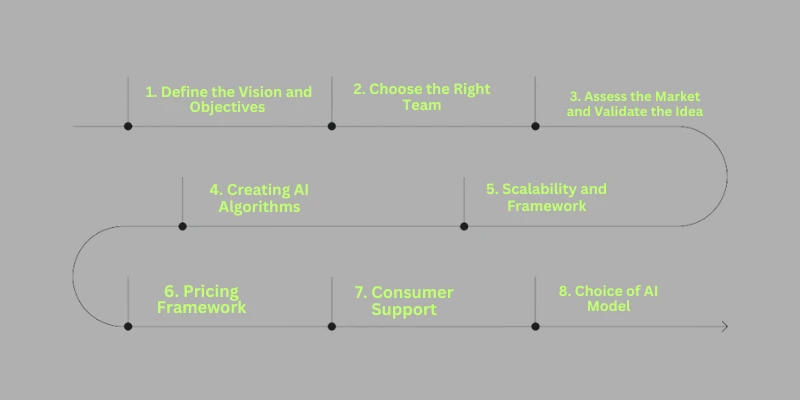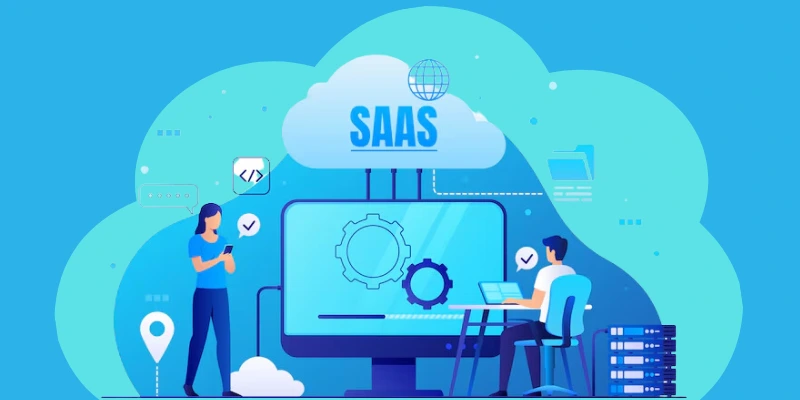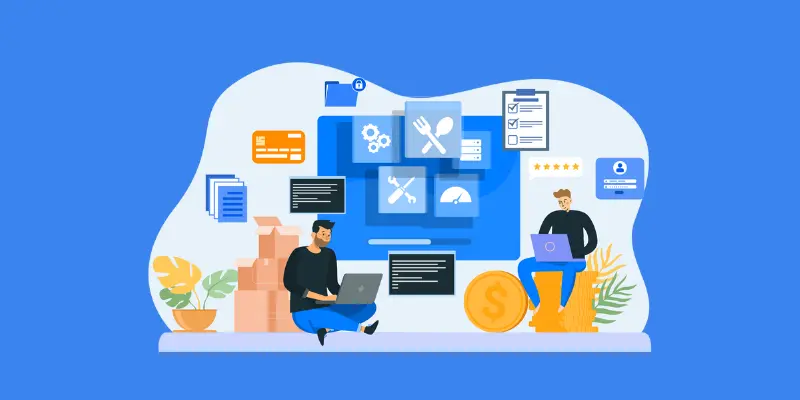SaaS application development as a delivery approach and AI as a technology for augmenting the capabilities of software products go hand in hand. As per the findings of the IBM survey, 28% of the companies have a defined AI strategy in 2022, and 37% are developing it. Given that as many as 70% of software was delivered as SaaS products in the same year, we can say the SaaS market for AI-powered applications is becoming increasingly competitive.
The integration of cloud-based software and artificial intelligence into our technological lives has been crucial and is inducing change, affecting the state of technology presently. Organizations and consumers seek smarter solutions and more effective answers as the demand for AI-powered SaaS products grows at an unprecedented rate. This article focuses on the relevance of AI-SaaS development services and guides people on the best ways to navigate successfully in developing one.
What is an AI SaaS Exactly?
Artificial intelligence as a service is referred to as AI SaaS, and this has been able to revolutionize how individuals can freely access and exploit AI technologies. It integrates the scale of usage flexibility and the capabilities of artificial intelligence through the use of the SaaS development concept. Cloud-based software solutions of AI SaaS make AI functions and services available to a large audience through subscription-based models. It forms a design based on key concepts of scalability, affordability, accessibility, and personalization. It democratizes AI use and adapts it to numerous specialized use cases so that varied organizations of any size can benefit from AI while not carrying the burden of high initial expenses and expertise.
AI is revolutionary in the domain of SaaS development services. AI improves automation, simplifies workflows, provides deeper insights, and customizes the user experience in SaaS application development. The predictive capabilities of AI-based SaaS solutions enable smarter forecasting and decision-making support, giving businesses a competitive edge through data-driven decision-making. AI SaaS is growing in a new generation of creativity and efficiency on a digital front.
Also Read : How to Build a Scalable Cloud-Based App for Your Growing Business?
Critical Steps to Build an AI SaaS Product

A SaaS solution with AI is very complex and thus requires careful planning and implementation. Below are the critical stages that will walk you through the process:
1. Define the Vision and Objectives
Specific goals will define any AI SaaS project. First, the problem that the product will solve should be described; then, who will use it, and a statement of quantifiable goals should be made. Explicitly defined goals, acting simultaneously as success checkpoints, help the development process.
It seeks to solve the challenge of interpreting and analyzing complex data. Streamlining the extraction of insights from complex, divergent datasets will reduce the time and expertise required to investigate. An AI SaaS platform helps data analysts, business decision-makers, and researchers receive immediate insights into the complexity of data analyses. In this respect, the main goal of this platform is to provide actionable insights along with scalability and customization, practical data interpretation, and an intuitive user experience.
2. Choose the Right Team
The key to your project's success is not only assembling the best team possible with relevant experience but also having experience in a field that fits within your project. This is an all-inclusive guide to finding, assessing, and choosing a software development team that can help breathe life into your AI SaaS product idea.
Browse through websites such as Clutch, Upwork, or LinkedIn that provide access to software development teams. Websites like Clutch may offer ratings and reviews that showcase the capability and performance of different businesses. In addition, one can reach established developers or teams working in the niche of SaaS development and AI development by participating in discussion forums like Stack Overflow or GitHub. This would help one understand the technical capability of a particular team.
Review portfolios for prospective teams meticulously. Look out for those projects that echo your objective for your AI SaaS product and how wide-ranging and detailed their comprehension of the industry is. Consider also searching for case studies and testimonials from previous clients to understand better the workings of the team and how they can solve problems.
Assess whether the team of SaaS application developers is aware of the tools and technologies needed for creating AI and SaaS applications. Make sure they understand cloud computing, machine learning frameworks, and other relevant technology. Get information about their development procedure and coding standards.
Clear communication is the essence of any project. To ensure a smooth process, assess how fast the team responds and through what communication channels. Lastly, remember to appreciate the methodology the team used in handling the project. Agile development approaches, which emphasize agility and iterative development, are often successful when applied to dynamic projects.
3. Assess the Market and Validate the Idea
Market research must be conducted in order to develop your AI SaaS product properly. This can involve researching your competitors, industry trends, and customer needs in relation to what unmet market opportunity lies ahead. Furthermore, we should validate the product idea based on user feedback. Prospective users should be involved through surveys, interviews, and prototype testing to identify the pain points of the users and the closer product to market demands. With this iterative process of doing market research and getting insights from the users, the best final product resonates effectively with the identified market.
4. Creating AI Algorithms
Finding and collecting datasets is just part of the process of preparing the data for AI algorithms. The first step in training AI algorithms is the identification of the needed data sources. Then, a detailed plan for collecting the data is created, including how to gather the needed datasets. This includes gathering information from diverse sources like databases, APIs, and other platforms to ensure diversity and adequate data for a good training of the model. Then, the data is cleaned and preprocessed to make sure it's accurate and reliable. Data preparation fills in the missing values, normalizes the data, and transforms the raw data into a format that could easily be used to create a consistent, high-quality dataset. Data cleaning assures the accuracy and integrity of the information used by identifying and correcting errors or inconsistencies in the dataset.
5. Scalability and Framework
The infrastructural design needs to be sound and expandable. Plan cloud computing with Google Cloud, Azure, and Amazon Web Services for excellent speed and high availability. Best practices in AI SaaS development need to be carried out in data storage, load balancing, and redundancy.
Hence, proper planning and implementation are necessary to enable AI-based SaaS application development through the development of a scalable architecture. There is a need to adapt serverless solutions and cloud computing to develop an adaptive architecture that can cope with the flexible needs and workloads of users. Such cloud-based solutions involve dynamic allocation of resources as they scale up without considerable investments in hardware. High performance, security, and availability also constitute crucial components of such architecture. The enhancement of the quality of the user experience and, at the same time, preserving the confidentiality and integrity of the data by implementing redundancy, security, and performance optimization for a platform since its dependability and responsiveness for users may be enhanced.
6. Pricing Framework
Therefore, a profitable pricing plan develops after much careful consideration. Depending upon the product characteristics and the market, the best model of pricing—whether it has to be subscription-based, freemium, or usage-based—must be chosen. Again, the right model can only be chosen if we know our user base and what they are willing to pay. The value must also be properly offered, which satisfies a range of user needs, depending on clearly identified different price tiers and matching feature sets. By applying this tiered model, consumers may avail of a service that would suit their needs the most.
We must continually evolve our pricing models and feature sets to devise a plan for pricing optimization and value delivery. A point of equilibrium will be where customers perceive the benefits of the good to outweigh the price, thereby maximizing customer happiness and retention.
7. Consumer Support
Proper support by customer service channels is the right way to deal with users' questions and problems. Multi-channel support allows users to resolve their needs quickly through chat, email, and knowledge bases. A company should intend to make customers happy by providing easy-to-understand resources and prompt support. User experience and pain points are known through regular collection and analysis of user feedback. Comment forms, surveys, and analysis of user behavior all provide insightful data. A mobile app development firm should try to seek areas for development by actively listening to meet the needs of consumers with the product.
Part of the iterative improvement process should involve hiring dedicated developers who include customer input in the development of the product. A company should iterate and improve the product regularly, using insights gleaned from customer input. This method will ensure that the product adapts to the user's requirements and preferences and provides much more value with an improved solution in the end.
8. Choice of AI Model
There are different stages in the process of selecting and generating an AI model that helps create effective and strong models. The first step in the approach is that of choosing the best algorithm by considering other possibilities, such as bespoke or pre-trained models. All these strategies have their benefits, though each uses either already-existing, pre-trained models or employs custom models to cater to specific needs.
Only strong models are based on ensuring quality through data cleaning and normalization and proper division of data into sets for training, validation, and testing. Then, the model is trained and adjusted, hyperparameters are optimized, and its performance is thoroughly verified and cross-validated to guarantee its accuracy. The model's value is assessed via data testing and different criteria to understand its effectiveness.
A model is developed iteratively, with regular retraining and continuous fine-tuning to enhance performance and adapt to evolving data. Once the model is refined, deployment into practical applications becomes crucial, ensuring a seamless transition from development to practical implementation. In the end, the journey recurs, emphasizing ongoing development, model refinement, and adaptation to changing data and user needs, resulting in an eternal cycle of optimization and improvement.
Conclusion
Developing a SaaS solution on the basis of AI is both a great innovation opportunity and an expansion in business scope. Now, sticking to a strategic roadmap would allow for an AI SaaS product that meets users' needs while differentiating it from peers in the crowded market by specific goals, recruiting the right SaaS application developers and their inputs, market research, and an iterative development process. Critical success elements include quality of data, compliance considerations, ethical considerations, and in terms of creating a strong feedback loop. With this, it can be ensured that your AI SaaS solution stays up-to-date and relevant, with a viable stand during the longer run and constant monitoring, optimization, and adaptability in your approach.













Share this blog